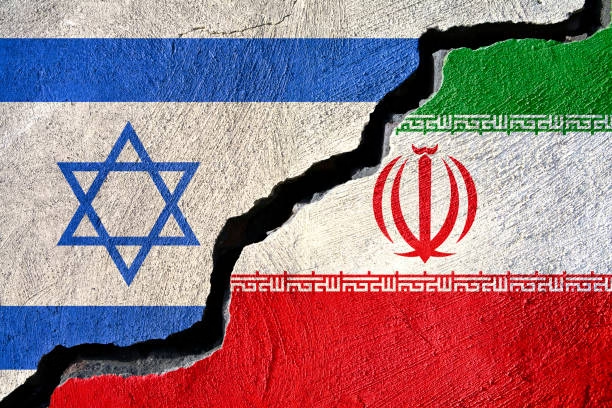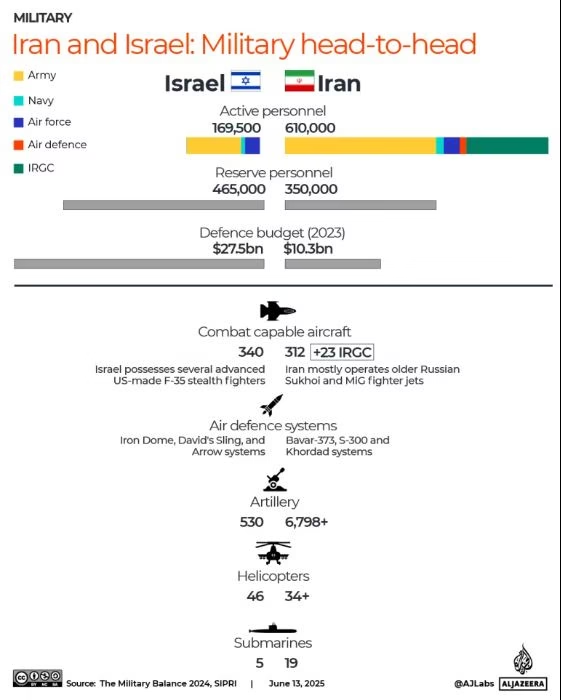# Israel vs Iran Missile Power: Full Comparison of Ranges, Defense Systems & Strike Capabilities (2025)
In the midst of rising Middle East tensions, the military rivalry between Israel and Iran has taken center stage—especially their missile capabilities. This detailed comparison breaks down the full missile arsenals of both nations in 2025, highlighting ranges, payloads, technology, and real-world battlefield effectiveness.
Israel, with its multi-layered defense systems like the Iron Dome, David’s Sling, and Arrow 3, has successfully intercepted the majority of incoming threats, thanks to its advanced radar, air superiority, and limited-use strategic weapons such as Jericho missiles. On the offensive side, it relies on precision long-range missiles and nuclear ambiguity to maintain deterrence.
Iran, on the other hand, fields one of the largest ballistic missile inventories in the world, including Fateh-110, Sejjil, Ghadr-110, and the newer Fattah-1 hypersonic missile. Though less accurate, Iran’s strategy is based on volume, saturation, and evolving technology aimed at overcoming Israeli defenses.
Explore our full analysis, comparison charts, and strategic insights to understand who holds the upper hand in a potential missile war. From range and payload to tech upgrades and AI-assisted targeting, this blog dives deep into what could define the next major conflict.
🇮🇱 Israel’s Air and Missile Capabilities
Air dominance: Israel’s recent operations—led by F‑35I, F‑16, and F‑15 jets—have dismantled over 120 Iranian air-defense systems, securing air superiority over parts of Iran reddit.com+2businessinsider.com+2time.com+2ft.com+3theguardian.com+3businessinsider.com+3.
Defense layers: A multi-tiered system includes Iron Dome (short-range), David’s Sling (medium-range), and Arrow 2 & Arrow 3 (long and exo-atmospheric)—claiming over 90% interception rates, though sustainability in prolonged war is a concern indianexpress.com+5ynetnews.com+5washingtonpost.com+5.
Strategic strike capability: Baseball-capable Jericho‑3 missiles (4,800–6,500 km) complement shorter-range LORA missiles. Israel’s ambiguity around its nuclear arsenal (≈90 warheads) adds strategic deterrence english.mathrubhumi.com+3middleeastinsightsplatform.com+3indiatoday.in+3.
🇮🇷 Iran’s Missile Arsenal
Volume and diversity: Estimated 3,000+ ballistic missiles, from short-range Fateh‑110 (300 km) to medium-range systems like Shahab‑3 (1,300 km), Ghadr‑110 (~2,000 km), Sejjil (~2,000 km), and long-range Khorramshahr/Kheibar Shekan (~2,000 km) economictimes.indiatimes.com+12en.wikipedia.org+12worldysnews.com+12.
Advanced types: Newer systems—Fattah‑1 (claimed hypersonic with maneuverable reentry), Khorramshahr‑4 (2,000 km range, 1,500 kg payload)—aim at evading modern defenses worldysnews.com+4english.mathrubhumi.com+4english.mathrubhumi.com+4.
Recent launches: Iran has fired 400–1,000 projectiles (SRBMs, MRBMs, drones); only ~10% penetrated Israel’s defenses, causing regional damage and some casualties livemint.com+5theguardian.com+5middleeastinsightsplatform.com+5.
🔍 Key Insights
Israel holds air dominance, crippling Iran’s defenses and scoring deep strikes ynetnews.com+15theguardian.com+15businessinsider.com+15.
Iran relies on mass saturation using ballistic missiles and drones, testing the limits of Israel’s layered defenses .
Defense sustainability: Israel’s interceptor stockpiles (Iron Dome, Arrow) are effective short-term but expensive, raising concerns for longer conflict .
Escalation risk: Iran’s new missiles (e.g., hypersonic Fattah‑1) may degrade defense efficacy—though unconfirmed—and could shift escalation dynamics english.mathrubhumi.com+9apnews.com+9edition.cnn.com+
| Missile | Range (km) | Warhead (kg) | Type | Notes |
|---|---|---|---|---|
| Fateh‑110 (Iran) | ~300 | 500 | SRBM solid‑fuel | Fast, accurate, road‑mobile :contentReference[oaicite:21]{index=21} |
| Kheibar‑Shekan | 1,450 | 550 | MRBM solid‑fuel | Maneuverable warhead, mid‑range :contentReference[oaicite:22]{index=22} |
| Ghadr‑110 | 1,800–2,000 | 650–800 | MRBM liquid/solid | Accurate upgrade of Shahab‑3 :contentReference[oaicite:23]{index=23} |
| Fattah‑1 | 1,400 | ~450 | Ballistic (claimed hypersonic) | Maneuverable reentry :contentReference[oaicite:24]{index=24} |
| Sejjil | 2,000 | 700 | MRBM solid‑fuel | Two‑stage, solid‑propellant :contentReference[oaicite:25]{index=25} |
| Khorramshahr/Kheibar‑4 | ~2,000 | 1,500 | MRBM liquid‑fuel | Heavy payload, strategic reach :contentReference[oaicite:26]{index=26} |
| LORA | ~430 | 570 | Quasi‑ballistic | Tactical strike missile :contentReference[oaicite:27]{index=27} |
| Jericho‑2 | 1,500 approx. | 1,000 | IRBM nuclear‑capable | Medium‑range nuclear deterrent :contentReference[oaicite:28]{index=28} |
| Jericho‑3 | 4,800–6,500 | 1,300 | IRBM/IABM | Strategic deep strike :contentReference[oaicite:29]{index=29} |
📝 Summary
Amount vs. Quality: Iran fields thousands of ballistic missiles but Israel maintains a smaller, highly precise strategic stockpile.
Defense Layers: Israel’s multi-tier defense (Iron Dome, David’s Sling, Arrow) effectively neutralizes most incoming threats—though cost and stockpile limits are a concern in prolonged conflict.
Escalation & Deterrence: Israel’s advanced air-force and strategic missile force dominate airspace and strike ability. Iran relies on saturation and emerging tech like hypersonics, but lacks the penetration and precision to overwhelm Israel long-term—at least not yet.
Disclaimer: This article is for informational and educational purposes only. It does not promote or support any conflict, nation, or military action. All data is based on publicly available sources and may change over time.
Policy Note: We strive for accuracy and neutrality. If you notice any misinformation or have concerns, please contact us for correction.





